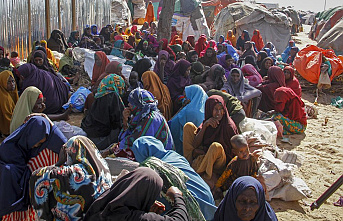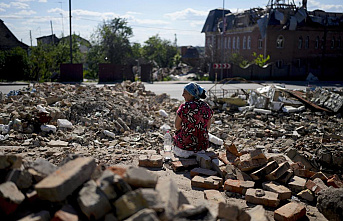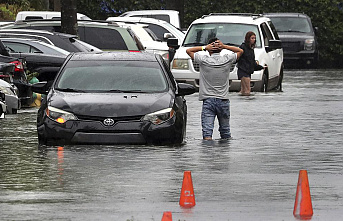locusts to kill, at best, between six o'clock in the evening and six o'clock in the morning. Then they are motionless, almost rigid. To fly, you need to save a little bit of heat in the body. Kenya's government wanted them to look actually, as long as you pink were brown and insatiable. The finger-length insects to dye first yellow, you will be lazy and lay eggs of about 300 per female. But now it is too late.
The swarms, which look like huge dark clouds in the day sky, came to the end of 2019 in East Africa. For Kenya, it is the worst Invasion for 70 years. By the North-East of the country, a swarm moved with almost 200 billion insects – 40 kilometres wide, 60 kilometres long. They destroy farmland, and since the government has in the fight against the animals have no choice, as the pesticides from the air are the consequences for the environment are enormous.
The food and agriculture organization of the United Nations (FAO) is expected in the coming months, massive crop failures, devastating for the more than two-thirds of the people in East Africa and the Horn of Africa, the life of agriculture. Local media reports of desperate people trying with sticks and metal rods to distribute the huge swarms.
Insatiable pests
"These things are insatiable", recently said Keith Cressman, an expert from the FAO. Even a small swarm of the insects destroyed in a single day, food for 35'000 people. A corn on the cob that has been infested by locusts, a type of brownish rust. The corn grits are inedible. As farmers lose their crop within a few minutes. The small-scale farmers in the Region normally use up to two-thirds of their crop and sell the Rest to markets. Environmental conservationist and paleontologist Richard Leakey has criticized the handling of the government with the looming environmental crisis in focus. The sprayed chemicals remained 30 years in the soil.
A man in Kenya is trying to scare away locusts. Photo: Reuters
Although the Kenyan government provided 200 million Kenyan shillings, approximately 2 million francs, to combat the Invasion. But it took me several weeks to respond to the plague. Neither enough pesticides or spraying a witness were available. Also Kenya's government is talking about the extent of the infestation small. At the end of January, the state news Agency reported that the locusts were "under control". The grasshoppers were a big Problem for Kenya, said President Uhuru Kenyatta, however, the crop losses may be less bad than feared.
International organizations disagree. You can expect a severe hunger crisis for the Region. Marlehn Thieme, the President of Welthungerhilfe, says Kenya's government to prepare the population to the crisis, but you don't have the feeling that the whole truth be told. In Kenya, two million people from starvation or malnutrition, are threatened, among them 500'000 refugees. The arable land after the plague fertile again, and will need a lot of time. In the worst case, the loss of a complete harvest of the threat in the affected regions.
elephants are threatened
The locusts could pose a threat to Kenya's elephants, the fear of environmentalists. The large herbivores living in national parks and protected areas and are important for the Kenyan tourism industry, in turn, is one of the important sectors of the economy of Kenya.
The locusts are not yet arrived in the capital, however, in other regions, such as Isolo or Kitu. The pesticides from the air can get into the drinking water for people and wildlife. The chemicals kill everything, even useful beetles, and bees, and bring the Ecosystem out of balance.
desert locusts are adaptable creatures, with warm temperatures and the right amount of rain, you will develop wings to swarm across oceans and continents. The swarms of Insects come originally from the Indo-Pakistan border. After a cyclone in 2018, the conditions for the pests were perfect, a drought drove them in the past year in Yemen. From there they crossed the Red sea, and came to Somalia and Ethiopia, Eritrea, Djibouti, and Kenya, now the democratic Republic of the Congo reports first swarms.
locusts moving fast: you can put back in good wind conditions of the day 150 km. The FAO is therefore one of the most dangerous flying pests. Now they spread also in the direction of South Sudan and Sudan, Uganda and Tanzania. The States of suffering, such as Kenya, are already under the effects of climate change, some of which are politically weakened, unstable and armed conflict anyway.
New Generation in the approach
Sudan is currently in a complicated political transformation process. The neighboring South Sudan, the youngest state in the world, is considered to be particularly fragile. According to the UN, more than 76 million US will be needed-dollars to be able to enough pesticides from the air spray. But so far no approach has come along way enough.
For the population in Somalia, the locusts is the plague of the additional burden. The people there suffer under the Terror of the Islamists militia al-Shabab. Now the country has declared a national state of emergency.
Kenya is the economic heavyweight in the Region – could be with the crisis is most likely finished. The credit rating Agency Moody's is concerned because of the crop failures, rising food prices and, subsequently, an increased risk for social unrest. The worst thing could stand before the country – when the locusts the fertile Rift Valley to reach the granary of the country. And in a few months, a new Generation of locusts from those eggs to hatch, which are just several inches under the earth, dug in. If in March the rain comes and the Region of new Vegetation provided, you can multiply the number of locusts sharply – by up to 500 Times.
Created: 28.02.2020, 08:13 PM
Date Of Update: 02 March 2020, 11:02










